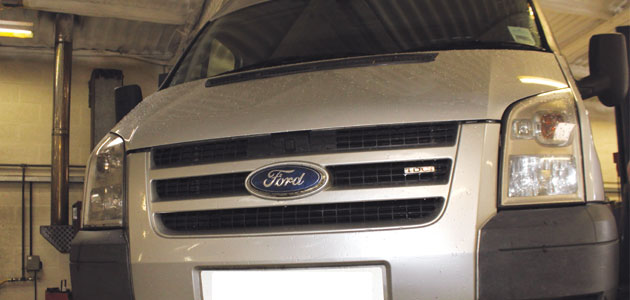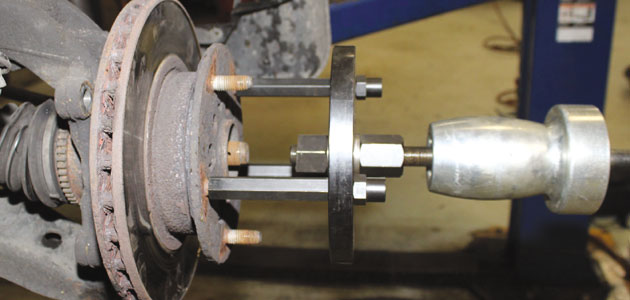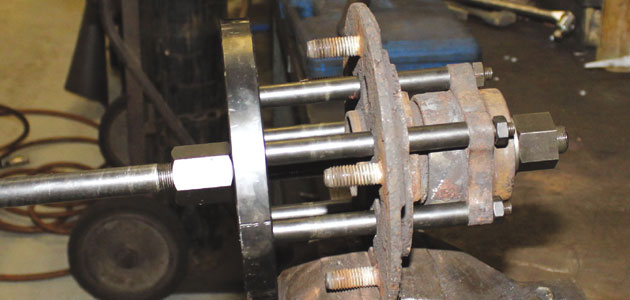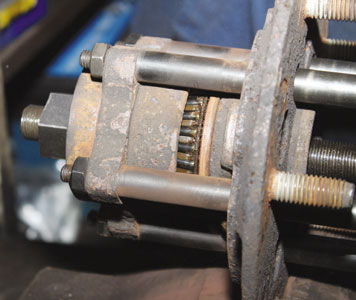
First introduced into the UK in 1965, the Ford Transit is now into its fifth generation. With over 800,000 vehicles on UK roads today, this article from FAG – a brand of Schaeffler Automotive Aftermarket – focuses on front LH wheel bearing replacement on the 2006+ model.
Front wheel bearing replacement on this model can prove tricky and we know of many independent garages who have been struggling with this particular application. For the repair you will require a torque wrench, a suitable press and a puller, as the old bearing will need to be extracted from the hub. The Sykes Pickavant removal and installation tool (08254500) was developed following complaints from garages and we used it for this repair with the vehicle on a two-post ramp.
First you need to determine the correct bearing for the application as two types are available depending on the payload – the first is up to 1,750kg and the second is up to 1,850kg. The bearing diameter is different and you will not be able to interchange them. You will find the payload for the vehicle on the nearside door pillar.
Raise the vehicle safely and remove the LH wheel. Remove the brake calliper by carefully squeezing the piston back and then removing the two securing bolts. Stow the calliper using a bungee tie, ensuring no strain is applied to the brake hose in the process, and attach it to the coil spring securely. Unclip the ABS sensor lead and stow safely. Remove the split pin and castellated cap and release the hub nut.
Remove the five torx bolts that hold the bearing to the hub assembly and suspension arm. To remove the hub assembly, install the three legs by fastening them to the hub studs as equally as you can. Install the impact plate onto the legs and secure in place with three top nuts. Now install the slide hammer assembly through the centre hole of the impact plate and hold in place using one large washer and nut either side of the plate.

With the hub ready to be removed, slide the hammer away from the hub as many times as required until it becomes free. This procedure should be done with two people so the hub can be removed safely, rather than letting the hub and tool drop suddenly.
Remove the brake disc
With the hub assembly removed, the brake disc will need to be removed before the bearing can be released from the hub. Release the five hexagonal bolts using a good quality socket, taking care not to round the bolt heads as they will be solid and rusted. With the brake disc removed, the bearing can now be pulled from the hub.
Push the five legs through the hub from the stud side, the bolt holes of the bearing and then secure in place with the nuts provided. Attach the impact plate to the legs by lining up the five recessed holes. Insert the slide hammer assembly rod through the centre hole and then through the drive shaft hole. Keep one of the larger nuts on the impact plate side. On the other end of the slide hammer shaft use the two large washers and the remaining large nut, making sure that as many threads are engaged as possible, before tightening against each other.

Secure the hub assembly and slide the hammer towards the back of the impact plate several times and then re-tighten the nuts, as they will become lose with each strike. Alternate between the slide hammer action and the tightening of the large nuts until the bearing comes free.

To remove the inner race, first install the backing ring to the bearing then position the bearing separator with the profiled sharp edges located between the back of the bearing and the hub.
Tighten the nuts equally, but not too tight, as you do not want to grab onto the drive flange. Install the five legs to the impact plate with the nuts provided and then install the legs through the hub from the stud side. Insert the slide hammer assembly through the impact plate and centre of the hub and attach the two large washers and nuts as before. Make sure the five legs are pressed squarely against the backing ring with pressure. Tighten the large nuts against each other until the bearing becomes free from the drive flange.
You may need some assistance by using the slide hammer. During this process ensure that the large washers are centred as they can become caught on the bearing during removal. Clean the hub and the drive flange, removing any dirt and rust before pressing the bearing into place. Install the bearing in the correct way and press onto the drive flange, applying the pressure to the inner race.
Clean the contact surface of the hub and brake disc and refit the disc to the hub, tightening them evenly and sequentially to the manufacturer’s tightening torque of 53Nm. Re-attach the hub carrier to the drive shaft and suspension arm and install the new hub nut. Do not tighten fully. Refit the brake calliper and tighten the bolts to 175Nm. As the brake calliper has been removed, it is advisable to pump the brake pedal a couple of times to allow the piston to return to its correct position. Refit the wheel and lower the vehicle. Tighten the hub nut in two stages: the first stage is 250Nm, and then rotate the wheel hub by five turns. The second stage is 500Nm, then rotate the wheel hub by five turns. Refit the new castellated cap and split pin.









